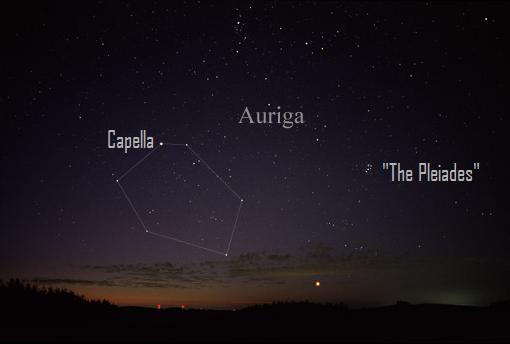Tonight – or any autumn or winter evening – if you can see the Big Dipper, use its famous pointer stars (which point to Polaris, the North Star) to find the bright golden star Capella in the constellation Auriga the Charioteer. The top two bowl stars point toward Capella, as we depict on the chart at the top of this post.
Capella is sometimes called the Goat Star. In fact, the star name Capella is the Latin word for nanny goat. Near Capella, you’ll find a tiny asterism – a noticeable pattern on the sky’s dome – consisting of three fainter stars. This little triangle of stars is called the Kids (baby goats).
The 2019 lunar calendars are here! Order yours before they’re gone. Makes a great gift.
The phrase spring up and fall down gives you some idea of the Big Dipper’s place in the evening sky. On fall evenings for us in the Northern Hemisphere, the Big Dipper sits way down low in the northern sky.
On northern spring evenings, the Big Dipper shines high above Polaris, the North Star.
From the Southern Hemisphere: Sorry, y’all. These are northern stars and not easily visible to you … unless you come visit our part of the world!
From the far southern U.S. and similar latitudes: You won’t see the Big Dipper on these November evenings, either. From more southerly latitudes in the Northern Hemisphere, the Big Dipper is below your northern horizon on autumn evenings. Even in the northern states, it’ll be possible to miss the Big Dipper if obstructions block your view of the northern sky. However, the Big Dipper swings full circle around Polaris, the North Star, once a day. Thus, from these latitudes, the Big Dipper will appear fairly high in the northeast sky before morning dawn in November.
It’s a long jump from the Big Dipper bowl stars to Capella. Our chart at top goes all the way from northwest to northeast. That’s about one-fourth the way around the horizon.
And remember, the Big Dipper and Capella move throughout the night, and throughout the year, but – no matter when and where you see them – they are part of the “fixed” star background … and so always maintain this relationship to one another.

The bright star Capella and its constellation Auriga the Charioteer as seen in the east-northeast sky. Image via Wikimedia Commons.
Bottom line: You’ve heard of the “pointer” stars of the Big Dipper? They point to the North Star. You can also use them to find the star Capella, aka the Goat Star.
Donate: Your support means the world to us
Enjoying EarthSky so far? Sign up for our free daily newsletter today!
Easily locate stars and constellations during any day and time with EarthSky’s Planisphere.
from EarthSky https://ift.tt/2BgjUAI
Tonight – or any autumn or winter evening – if you can see the Big Dipper, use its famous pointer stars (which point to Polaris, the North Star) to find the bright golden star Capella in the constellation Auriga the Charioteer. The top two bowl stars point toward Capella, as we depict on the chart at the top of this post.
Capella is sometimes called the Goat Star. In fact, the star name Capella is the Latin word for nanny goat. Near Capella, you’ll find a tiny asterism – a noticeable pattern on the sky’s dome – consisting of three fainter stars. This little triangle of stars is called the Kids (baby goats).
The 2019 lunar calendars are here! Order yours before they’re gone. Makes a great gift.
The phrase spring up and fall down gives you some idea of the Big Dipper’s place in the evening sky. On fall evenings for us in the Northern Hemisphere, the Big Dipper sits way down low in the northern sky.
On northern spring evenings, the Big Dipper shines high above Polaris, the North Star.
From the Southern Hemisphere: Sorry, y’all. These are northern stars and not easily visible to you … unless you come visit our part of the world!
From the far southern U.S. and similar latitudes: You won’t see the Big Dipper on these November evenings, either. From more southerly latitudes in the Northern Hemisphere, the Big Dipper is below your northern horizon on autumn evenings. Even in the northern states, it’ll be possible to miss the Big Dipper if obstructions block your view of the northern sky. However, the Big Dipper swings full circle around Polaris, the North Star, once a day. Thus, from these latitudes, the Big Dipper will appear fairly high in the northeast sky before morning dawn in November.
It’s a long jump from the Big Dipper bowl stars to Capella. Our chart at top goes all the way from northwest to northeast. That’s about one-fourth the way around the horizon.
And remember, the Big Dipper and Capella move throughout the night, and throughout the year, but – no matter when and where you see them – they are part of the “fixed” star background … and so always maintain this relationship to one another.

The bright star Capella and its constellation Auriga the Charioteer as seen in the east-northeast sky. Image via Wikimedia Commons.
Bottom line: You’ve heard of the “pointer” stars of the Big Dipper? They point to the North Star. You can also use them to find the star Capella, aka the Goat Star.
Donate: Your support means the world to us
Enjoying EarthSky so far? Sign up for our free daily newsletter today!
Easily locate stars and constellations during any day and time with EarthSky’s Planisphere.
from EarthSky https://ift.tt/2BgjUAI

Aucun commentaire:
Enregistrer un commentaire